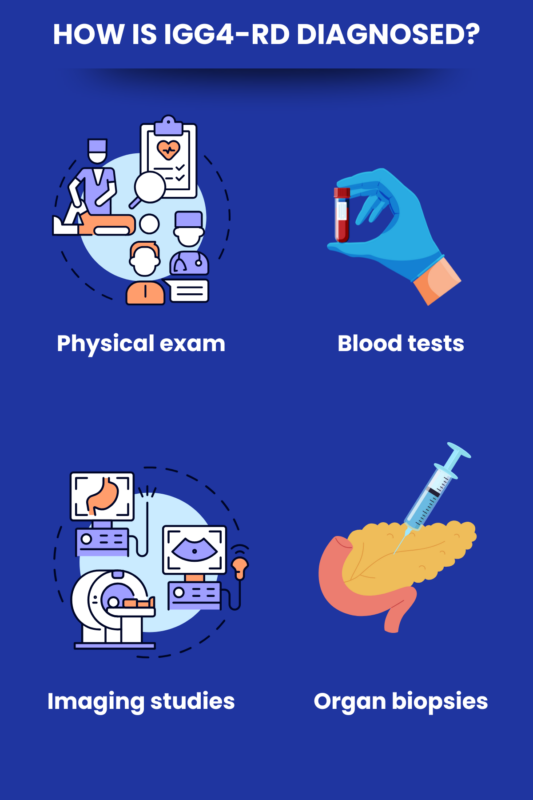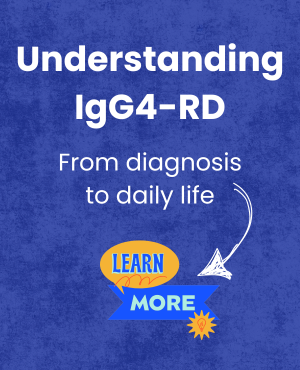IgG4-related disease diagnosis
Last updated May 23, 2025, by Lindsey Shapiro, PhD

Reaching a diagnosis of IgG4-related disease (IgG4-RD), an immune-mediated condition marked by tumor-like masses or swelling, can be difficult because the condition can manifest in many ways and resemble several other conditions. In addition, there aren’t any widely accepted IgG4-RD diagnostic criteria.
If IgG4-RD is suspected, doctors will usually run a number of different tests to confirm the diagnosis, which can include clinical, blood, imaging, and tissue studies.
IgG4-RD causes are incompletely understood, but the disease is characterized by immune cells that infiltrate tissues and cause inflammation and scarring (fibrosis). Some of these immune cells typically produce high amounts of immunoglobulin G4 (IgG4), a type of antibody. This immune cell infiltration, inflammation, and fibrosis can result in organ and tissue swelling and the formation of tumor-like masses, which over time can damage the organs.
While reaching an IgG4-RD diagnosis can be challenging, identifying the disease early is important to ensure that patients receive proper treatment as soon as possible, preferably before substantial organ damage occurs.
How is IgG4-RD diagnosed?
There’s no one specific IgG4-RD test, and reaching a diagnosis typically involves a combination of findings from physical exams, blood tests, imaging studies, and histopathology (microscopic examination of tissues to identify disease-associated changes).
Often, a doctor will first suspect IgG4-RD if they see enlargement or masses in commonly affected organs such as the pancreas, kidneys, tissues surrounding the eyes, salivary glands, or the retroperitoneum (the area in the back of the abdomen).
Diagnostic criteria
There is no set of universally accepted IgG4-RD diagnostic criteria, but there are a few different existing guidelines. For example, the American College of Rheumatology and the European League Against Rheumatism jointly developed a set of classification criteria in 2019 that involves three sequential steps:
- Identifying signs of involvement of at least one of 11 possible organs and tissues consistent with IgG4-RD.
- Checking for characteristics of other diseases that can mimic IgG4-RD that could exclude IgG4-RD.
- Identifying typical IgG4-RD features in clinical exams, blood tests, imaging scans, and histopathology that result in a total score that indicates the likelihood of a possible IgG4-RD diagnosis.
Another commonly used framework is the 2020 revised Japanese Comprehensive Diagnostic Criteria, which looks for the presence of:
- characteristic swellings or tumor-like masses in one or more organs/tissues
- high blood IgG4 levels
- certain histopathological features suggestive of IgG4-RD.
Having all of these features provides a definite diagnosis, while having a combination of two features indicates a probable or possible diagnosis, based on the specific features that are present.
While both of these guidelines provide a framework that can help diagnose IgG4-RD, clinicians have to use their own clinical judgment to decide if someone has the disease. A person could still be diagnosed with the disease even if they don’t meet all these criteria.
Medical history and physical exam
In the presence of possible symptoms or signs of IgG4-RD, a doctor will collect a thorough medical history and conduct a physical exam.
For the medical history, the doctor will try to better understand which symptoms the person has been experiencing that may suggest IgG4-RD and specific organ involvement. A previous history of certain conditions that are recognized as different manifestations of IgG4-RD since the early 2000s may also help to diagnose the disease.
A physical exam may include careful examination of the eyes and surrounding tissues, as well as of salivary glands, whose enlargement is suggestive of IgG4-RD.
Lab testing
Although there’s nothing that can be measured in the blood that is entirely specific to the disease, blood tests are an important part of the diagnostic process. They are not sufficient, however, to warrant a diagnosis on their own.
Some things that might be checked for during the diagnostic process of IgG4-RD include:
- blood, or serum, IgG4 levels, often but not always elevated in IgG4-RD
- blood levels of IgG and IgE antibodies, which can be higher than normal in IgG4-RD
- erythrocyte sedimentation rate (ESR) and C-reactive protein (CRP), two markers of inflammation that can be mildly elevated in IgG4-RD
- blood levels of self-reactive antibodies that are sometimes elevated in IgG4-RD, such as antinuclear antibodies or rheumatoid factor
- blood levels of proteins belonging to the immune complement cascade, which can be low in some IgG4-RD patients
- blood counts of eosinophils, a type of immune cell that can be elevated in IgG4-RD, a condition called eosinophilia
- blood levels of self-reactive antibodies specific to other autoimmune diseases, to help rule them or IgG4-RD out.
Imaging studies
Imaging tests such as MRI, CT scans, or ultrasound of suspected areas of disease involvement can show masses and areas of damage associated with IgG4-RD. However, these exams cannot distinguish between cancerous and noncancerous masses.
A PET scan can also reveal areas of active inflammation in IgG4-RD, but such activity could be indicative of other inflammatory disorders or cancer.
Histopathology
A biopsy, where a small sample of tissue is removed and sent to the lab for analysis, is often considered the most important and definitive diagnostic step for IgG4-RD. Analyzing a sample of affected tissues or organs under a microscope allows the identification of typical IgG4-RD features such as:
- dense immune cell infiltration, especially of plasma cells that secrete IgG4 and lymphocytes
- storiform fibrosis, or scarring in a characteristic swirling or “cartwheel” pattern
- obliterative phlebitis, or blockage of small to medium-sized veins due to immune cell infiltration and inflammation.
A biopsy can also rule out cancer as a cause of tumor-like masses, and may help rule out other inflammatory conditions.
But as with other types of tests, biopsies are limited because characteristic IgG4-RD features are not seen in every tissue sample, and can also occur in other diseases. It can also be hard to obtain a tissue sample for a biopsy, depending on the affected organ.

Diagnostic challenges
Identifying IgG4-RD can be very challenging for a number of reasons, and patients may wait a while to get the right diagnosis.
IgG4-RD became recognized as its own distinct condition in the last couple of decades. Because of that, awareness in the clinical community is still growing, and a universal set of criteria that can definitively establish a diagnosis has yet to be developed.
Moreover, early IgG4-RD symptoms and features are generally nonspecific, mild, or even absent, with some cases being diagnosed incidentally via imaging scans performed for other reasons.
Symptoms can also overlap substantially with other conditions, and these differential diagnoses must be ruled out during the diagnostic process:
- Organ swelling or masses can be confused with cancer, which can be excluded with a biopsy.
- IgG4-RD symptoms and organ involvement can overlap with other autoimmune and inflammatory diseases like Sjögren’s syndrome, primary sclerosing cholangitis, granulomatosis with polyangiitis, sarcoidosis, rheumatoid arthritis, or multicentric Castleman disease, which can often be ruled out with a combination of blood tests and biopsy.
- Infections can also cause organ swelling or inflammation, but can often be rejected by a lack of fever.
Ultimately, doctors have to very carefully look at the entire clinical picture to make these distinctions and ensure IgG4-RD is accurately diagnosed.
Next steps following a diagnosis
After an IgG4-RD diagnosis, patients should work closely with their healthcare team to come up with an appropriate treatment and management plan. Because the disease can affect multiple organs, this may involve a multidisciplinary team including a rheumatologist — who specializes in inflammatory and autoimmune diseases — and other medical experts.
While IgG4-RD is often controlled with appropriate treatment, it is a chronic condition that usually requires ongoing management. Appropriate care can help avoid serious organ harm, potentially approaching IgG4-RD life expectancy to what is seen in the general population. It is crucial that patients regularly meet with their healthcare team to ensure the best possible outcomes in their case.
IgG4-RD News is strictly a news and information website about the disease. It does not provide medical advice, diagnosis, or treatment. This content is not intended to be a substitute for professional medical advice, diagnosis, or treatment. Always seek the advice of your physician or other qualified health provider with any questions you may have regarding a medical condition. Never disregard professional medical advice or delay in seeking it because of something you have read on this website.
Recent Posts
- A chiropractor’s functional approach provides relief from my spine issues
- Genome study finds new genetic risk factors predicting IgG4-RD
- Rare IgG4-related GI disease often mistaken for stomach tumors
- With IgG4-RD, disease remission is a process toward progress
- Autoimmune conditions seen in 1 in 10 IgG4-RD patients: Study





